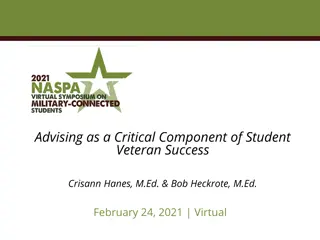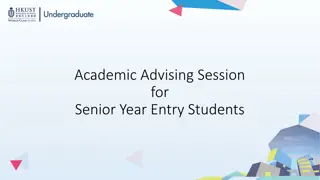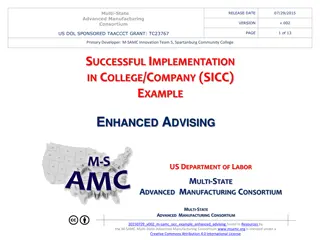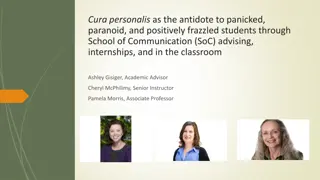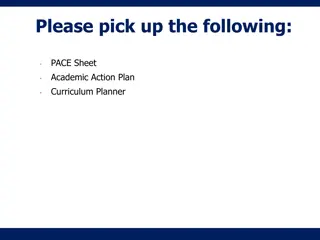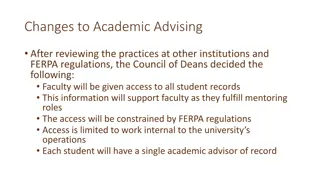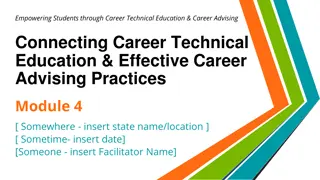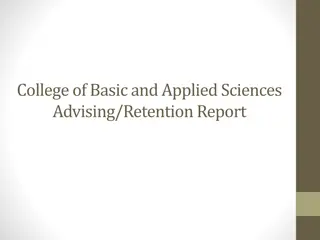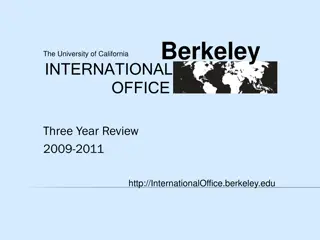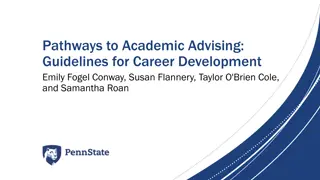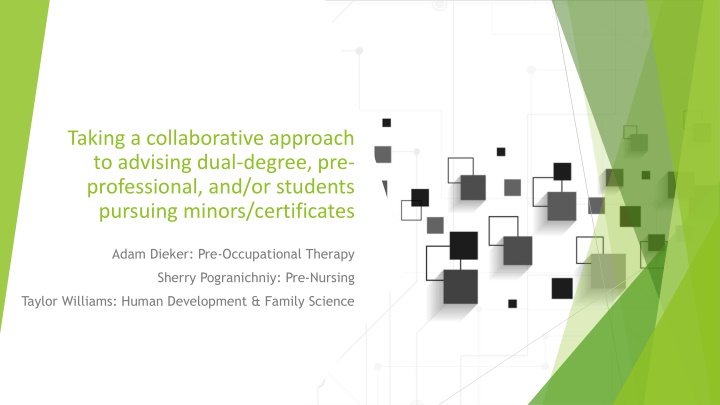
Collaborative Approach to Dual-Degree & Pre-Professional Advising
Explore the benefits of collaborative academic advising for students pursuing dual degrees or pre-professional programs like Pre-Occupational Therapy and Pre-Nursing. Student feedback highlights the efficiency and clarity achieved through joint appointments with primary and secondary advisors, promoting a streamlined planning process and reducing email correspondence.
Download Presentation

Please find below an Image/Link to download the presentation.
The content on the website is provided AS IS for your information and personal use only. It may not be sold, licensed, or shared on other websites without obtaining consent from the author. If you encounter any issues during the download, it is possible that the publisher has removed the file from their server.
You are allowed to download the files provided on this website for personal or commercial use, subject to the condition that they are used lawfully. All files are the property of their respective owners.
The content on the website is provided AS IS for your information and personal use only. It may not be sold, licensed, or shared on other websites without obtaining consent from the author.
E N D
Presentation Transcript
Taking a collaborative approach to advising dual-degree, pre- professional, and/or students pursuing minors/certificates Adam Dieker: Pre-Occupational Therapy Sherry Pogranichniy: Pre-Nursing Taylor Williams: Human Development & Family Science
Primary Advisor vs. Secondary Advisor Different roles have different nuances As a primary advisor: degree requirements, university requirements, class order, knowledge of when certain classes are offered, etc. As a secondary advisor: course requirements/order, extracurricular requirements, assisting with application process/deadlines, etc. Things are ever-changing on both sides
Collaborative Advising for Fall 2023 How we started Survey sent out by primary advisor to seek interest Student scheduled their Zoom or in-person appointment through Navigate with primary advisor Primary advisor sent Outlook invitation to secondary advisor (giving option to attend in-person or via Zoom) Number of collaborative appointments scheduled 10 pre-nursing 4 pre-OT 5 virtual vs. 9 in-person
Student Feedback HDFS Pre-Nursing Student: I appreciated the collaborative advising appointment because I could get both meetings done at one time and clearly create my next semester plan that works for both degrees. I was also able to get all my questions answered from both advisors at one time and didn t have to worry about emailing back and forth with both advisors to make sure everything was good to go. The collaborative meeting was easy and helpful, and I would definitely appreciate it if the collaborative meetings were continued. HDFS Pre-Nursing Student: I found the dual academic advising meeting very helpful and time efficient. It was easy to have questions answered from both sides all in the same meeting without creating confusion. HDFS Pre-OT Student: I appreciated being able to meet with Taylor and Adam together to discuss my class schedule and future plans. It was well organized and much easier to communicate with both of them simultaneously versus meeting with them both separately and trying to compare the appointments. Overall, it was productive and time efficient for us all. HDFS Pre-OT Student: It made it really easy to ask all of my questions and have the answers right there without having to wait for an email back after the meeting. I also liked being able to discuss what classes worked best with my major but also with grad school applications!
Collaborative Advising Benefits Less back-and-forth, cutting down on e-mails Student and advisors are on the same page nothing getting lost in translation Long-range plan can be completed simultaneously (and accurately) with both advisors present
Collaborative Advising Barrier Navigate does not allow a campaign to come from two advisors Scheduling with one advisor, then adding the second means time conflicts can't be avoided
Discussion What do you see as the pros and cons of using collaborative advising: Continuing students vs. New First-year students vs. Transfers In-person appointments vs. Virtual What barriers can you see happening (prior to or during appointments)?



